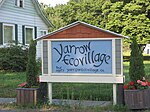Yarrow, British Columbia
Lower MainlandMennonitism in British ColumbiaNeighbourhoods in Chilliwack

Yarrow is a small community located 90 kilometres east of Vancouver within the City of Chilliwack in British Columbia, Canada. It is in the Fraser Valley at the foot of Vedder Mountain. The village was first settled by Mennonites in the late 1920s, following the draining of Sumas Lake and the reclamation of the former lake bed for agriculture.
Excerpt from the Wikipedia article Yarrow, British Columbia (License: CC BY-SA 3.0, Authors, Images).Yarrow, British Columbia
Community Street, Chilliwack Yarrow
Geographical coordinates (GPS) Address Nearby Places Show on map
Geographical coordinates (GPS)
| Latitude | Longitude |
|---|---|
| N 49.086 ° | E -122.052 ° |
Address
Community Street
Community Street
V2R 5E0 Chilliwack, Yarrow
British Columbia, Canada
Open on Google Maps




